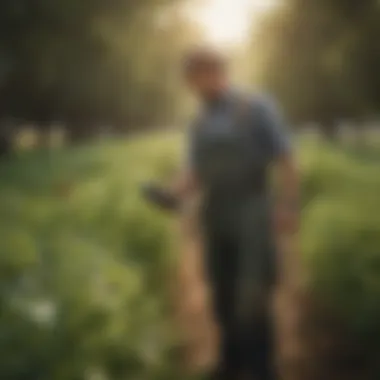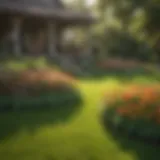Ecosmart Organic Pest Control Strategies Explained


Preventive Pest Control Strategies
Pests can pose significant challenges for homeowners. The best solution starts long before problems appear, focusing instead on prevention. This approach can save time, money, and stress. Implementing preventive pest control strategies requires awareness and consistent effort across different areas of your home and yard.
House Exterior Protection
Your home's exterior is the first line of defense against invading pests. Simple methods can minimize the risk.
- Tips for sealing cracks: Inspect your walls and foundations for any cracks or gaps. Filling these with appropriate sealants can stop pests from entering your home. Pay attention to areas around pipes and vents where gaps are more likely to occur.
- Clearing debris: Regularly remove debris such as fallen leaves and other organic matter from your yard. Piles of debris can harbor pests, offering them shelter.
- Preventing pests from entering: Ensure that doors and windows fit snugly. Weatherstripping can help seal openings and discourage pests from squeezing through.
Yard Maintenance
A well-maintained yard serves as a barrier against many pests. Regular care routines play an essential role in this.
- Essential yard care routines: Regular mowing and trimming help eliminate breeding sites for insects like mosquitoes. Keeping shrubs neatly trimmed allows sunlight to penetrate, reducing damp areas where pests may thrive.
- Methods for keeping yard pest-free: Employ natural deterrents in your garden, such as certain plants that repel insects. This strategy can be effective in maintaining a pest-free environment.
Indoor Cleanliness
An orderly and clean indoor space is less inviting to pests. Routine cleaning habits are pivotal.
- Expert cleaning tips and techniques: Vacuum floors and upholstery regularly. Pay special attention to corners and under furniture, where food particles can accumulate.
- Maintaining a pest-resistant indoor environment: Store food in sealed containers and promptly clean up spills. Keep surfaces clean to deter unwanted guests.
Garbage Disposal
Proper trash disposal is critical in pest control. It reduces the availability of food sources for pests.
- Efficient waste disposal methods: Use bins with tight-fitting lids. Ensure garbage is disposed of regularly to minimize odors that attract pests.
- Importance of proper garbage disposal: A cluttered waste area can be a haven for rodents and insects. Regular checks can prevent infestations.
Other Pest Prevention Strategies
Finding new ways to protect your home can enhance your efforts in pest control.
- Innovative ways to safeguard your home: Consider using barriers such as mesh screens in vents or under doors. This can stop pests from entering your home while allowing airflow.
"Effective pestcontrol begins with sound preventive measures. Taking steps today can save considerable trouble later."
Identifying Pest Risk Areas
Identifying areas prone to pest issues is essential. Regular inspections can be highly beneficial.
Moisture Prone Areas Inspection
Moisture attracts several kinds of pests. Identifying and managing these areas is vital.
- Identifying damp conditions: Check basements, attics, and crawl spaces for moisture. Inspect plumbing for leaks, as these can create prime conditions for pests.
- Tips for preventing infestations: Use dehumidifiers in damp areas and ensure proper ventilation. Frequent checks can maintain a dry environment that discourages pests.
Crack and Crevice Inspection Guide
A thorough inspection for cracks can reveal access points.
- Importance of inspecting access points: Regular inspection of doors, windows, and foundations can uncover hidden entry points.
- Strategies for sealing cracks and crevices: Use caulk or expanding foam to fill in gaps. This method can significantly reduce the likelihood of pest incursions.
Greenery Inspection for Pest Risks
Plants can attract pests or harbor them. Monitoring your greenery is essential.
- Understanding greenery's impact on pests: Trees and shrubbery can be homes for various insects. This can increase the chance of them entering your home.
- Guidelines to maintain pest-free yards: Regularly trim overgrown plants and remove dead branches that could attract pests.
Additional Pest Risk Areas


Awareness of numerous pest risk areas helps with prompt action.
- Miscellaneous pest risk areas and preventive measures: Areas like storage rooms, garages, and outdoor kitchens require attention. Ensure that these spaces are clear of debris and well-organized to avoid attracting pests.
Combatting pest issues demands a proactive attitude and preventive strategies. Creating a solid foundation for pest management is crucial in maintaining a healthy home.
Understanding Ecosmart Organic Pest Control
Ecosmart organic pest control represents a pivotal shift in how we approach pest management in modern agriculture and gardening. This section endeavors to elucidate the significance of ecosmart methods, emphasizing their ecological balance and sustainability. Understanding this topic is crucial not only for effective pest management but also for promoting a healthier environment.
Ecosmart pest control encompasses methods that minimize chemical inputs while maximizing the use of natural processes. This nuanced approach results in healthier plants, reduced chemical exposure, and enhanced biodiversity within ecosystems. By employing organic methods, we contribute to the sustainability of agricultural practices, which is an essential consideration for many housewives and homeowners who seek to cultivate their gardens responsibly.
It is imperative to consider the long-term benefits of embracing ecosmart pest control. This approach often leads to lower costs associated with pest management in the long run. By investing time in understanding types of pests, their lifecycles, and the ecological systems in which they thrive, individuals can develop effective strategies that protect their gardens without harming beneficial organisms or the environment.
Defining Ecosmart Pest Control
Ecosmart pest control can be defined as a strategy that prioritizes environmentally friendly methods to manage pests, focusing on the preservation of natural pest predators and minimizing the use of chemical pesticides. The world of ecosmart comes from the realization that not all pests are detrimental to a garden.
In fact, many insects act as natural predators, keeping harmful pest populations in check. This understanding is the bedrock of ecosmart pest control, fostering an ecosystem where beneficial organisms thrive alongside cultivated plants. For instance, ladybugs that consume aphids can be encouraged within a garden, reducing the need for synthetic pest control measures.
The Importance of Organic Methods
Organic methods in pest control are not simply an alternative; they represent a necessary evolution in agricultural practices, especially in home gardening. The significance of organic methods lies in their capacity to ensure soil health, promote biodiversity, and preserve water quality. Using organic techniques, housewives and homeowners can cultivate pest-resistant plants and ecosystems effectively.
Moreover, the combination of organic methods minimizes the risk of chemical contamination in our food systems. The use of harmful pesticides can lead to residue accumulation in crops, adversely affecting human health. By integrating organic pest control measures such as insecticidal soaps, neem oil, and diatomaceous earth, individuals can protect their plants while ensuring food safety.
"Choosing ecosmart organic pest control is not just about managing pests; it's about fostering a balanced environment that benefits our health and the planet."
In summary, understanding ecosmart organic pest control involves recognizing its significance in promoting sustainable gardening and agriculture. Through the integration of organic methods, individuals not only protect their gardens from pests but also contribute to the well-being of the environment. This foundational knowledge is essential for those committed to a responsible and effective approach to pest management.
The Science of Organic Pest Control
Understanding the science behind organic pest control is essential. This knowledge not only helps in implementing effective methods but also in appreciating the broader impacts of these practices on ecological health. Organic pest control methods rely on natural and sustainable techniques to manage pests, reducing reliance on synthetic chemicals. This approach promotes a balanced ecosystem while minimizing harm to beneficial organisms and the environment.
Biological Control Mechanisms
Biological control mechanisms are a central aspect of organic pest management. They utilize natural enemies to control pest populations. These enemies include predators, parasites, and pathogens that naturally occur in the environment. For instance, ladybugs feed on aphids, significantly reducing their numbers without the need for harmful chemicals.
In addition, the introduction of beneficial organisms can provide long-term pest control.
- Predators: Animals that hunt pests.
- Parasitoids: Insects that lay eggs on or in host pests.
- Pathogens: Microorganisms that cause diseases in pests.
Using these biological agents fosters an environment where pests are kept in check naturally. This method is often cost-effective and environmentally friendly. It is essential to monitor these natural controls and their effectiveness regularly.
Natural Pesticides and Their Efficacy
Natural pesticides represent another facet of organic pest control. These substances are derived from plants, minerals, or microorganisms, providing a safer alternative to synthetic pesticides. Examples include neem oil, diatomaceous earth, and insecticidal soaps. These products often target specific pests while being less harmful to non-target species, including humans and pets.
Effectiveness varies based on numerous factors such as pest species and environmental conditions.
- Neem Oil: Disrupts pest life cycles and can reduce feeding.
- Diatomaceous Earth: Causes dehydration in soft-bodied insects.
- Insecticidal Soaps: Work on contact and can suffocate pests.
In practical terms, using natural pesticides can lead to healthier plants and ecosystems. It is important to follow application guidelines closely to maximize effectiveness and minimize risks.
Soil Health and Pest Management
Soil health plays an integral role in pest management. Healthy soil supports robust plant growth. This resilience often leads to plants that can tolerate or resist pest infestations.
Practices that enhance soil health include:


- Composting: Adds organic matter and supports beneficial organisms.
- Crop Rotation: Disrupts pest life cycles by varying plant species in a given area over time.
- Cover Cropping: Prevents soil erosion and improves nutrient content.
A focus on soil health fosters a dynamic ecosystem above and below ground. Healthy soils support a diverse community of organisms, including those that can help manage pest populations. Ultimately, investing in soil health is an investment in long-term pest control.
Common Techniques in Ecosmart Pest Control
Ecosmart pest control encompasses various techniques that prioritize sustainability while effectively managing pest populations. Understanding these methods is vital for homeowners and housewives aiming to create healthier environments. Incorporating ecosmart strategies contributes not only to pest management but also to soil health and biodiversity. These methods minimize chemical usage, reducing potential harm to beneficial organisms. All of this fosters a balanced ecosystem that provides long-term solutions to pest issues.
Crop Rotation Strategies
Crop rotation is a fundamental technique in organic pest control that involves changing the type of crops grown in a specific area over time. This approach breaks the life cycles of pests, as many pests are adapted to thrive on specific plants. By rotating crops, the pest populations are reduced naturally. For instance, planting legumes one year can increase soil nitrogen levels and deter certain soil-borne pests in subsequent seasons.
Implementing a crop rotation plan gives several benefits. It not only disrupts pest cycles but also improves soil structure and health. This enhances nutrient availability and reduces the chances of soil erosion. When executed effectively, crop rotation transforms a typical garden into an adaptive ecosystem.
Companion Planting
Companion planting is another technique that involves placing certain plants together to achieve mutual benefits. This strategy works on the principle that some plants repel pests naturally or attract beneficial insects. For example, marigolds are known to deter nematodes and attract pollinators. Such combinations can greatly enhance the overall health of a garden.
Effective companion planting requires some planning. Homeowners should research which plants work well together and create a layout that maximizes these benefits. By attracting beneficial insects and reducing the pest population naturally, this technique reinforces the garden's resilience, and importantly, enables homeowners to enjoy their spaces with greater peace of mind.
Physical Barriers and Traps
Using physical barriers is a straightforward yet effective method in ecosmart pest control. This practice includes using nets, row covers, or even fences to physically block pests from reaching crops. Traps, like sticky traps or pheromone traps, can also monitor and reduce pest populations.
Physical barriers are particularly useful for preventing larger pests such as rabbits or deer. They are an excellent choice for homeowners wanting to maintain a visually appealing environment while protecting their gardens. The effectiveness of these barriers may require some maintenance, but they provide a significant reduction in pest incidents.
Homemade Organic Solutions
In addition to the methods mentioned above, homeowners can explore homemade organic solutions for pest control. These include mixtures made from common household ingredients, such as soap sprays or garlic solutions. These remedies can repel various pests without toxic chemicals.
Creating homemade solutions is economical and accessible. Furthermore, these mixtures can be customized according to specific pest problems. For example, a simple soap solution can target soft-bodied insects like aphids, while a garlic brew may deter a range of pests due to its strong scent. By integrating homemade remedies, housewives can ensure a pest-free environment without compromising their values on sustainability.
Implementing Ecosmart Pest Control Methods
Implementing ecosmart pest control methods is essential in integrating comprehensive strategies that address pest management while promoting environmental health. This section discusses key elements related to executing these methods effectively. It also outlines the benefits of such approaches and the considerations that home and property owners must keep in mind.
Assessing Pest Infestations
Before employing ecosmart pest control techniques, it is crucial to assess the type and extent of pest infestations. Understanding the severity of an infestation helps in deciding the appropriate methods to apply. Homeowners can start by observing visible signs of pests, like droppings or damage to plants. They should also consider the following points:
- Identify the species involved (insects, rodents, etc.) to tailor the approach.
- Assess environmental factors that might be attracting pests, such as food sources or suitable habitats.
- Determine the scale of the infestation to select the most effective and eco-friendly management strategies.
Investing in a thorough assessment can significantly improve the chances of successful pest management and reduce unwanted harm to beneficial organisms in the ecosystem.
Developing Integrated Pest Management Plans
Once pest infestations are properly assessed, the next step is developing Integrated Pest Management (IPM) plans. IPM is a systematic approach that combines various management strategies to control pests sustainably. Key elements of developing an IPM plan include:
- Setting Action Thresholds: Establish levels of pest activity that will trigger control measures. This helps avoid unnecessary interventions.
- Combining Methods: Use a mix of cultural, biological, mechanical, and chemical controls, placing emphasis on those that are organic and less harmful.
- Regular Monitoring: Constant assessment of pest populations and the effectiveness of control measures are necessary for adapting strategies promptly.
- Education and Awareness: Informing household members about the plan ensures everyone understands their role in maintaining pest management practices.
Implementing a well-defined IPM plan can minimize pesticide use while effectively managing pest populations, leading to better outcomes for both crops and the environment.
Monitoring and Evaluation
Monitoring and evaluation are critical elements in the ecosmart pest control framework. These processes allow homeowners to gauge the effectiveness of the implemented strategies and make necessary adjustments. Important aspects to consider include:
- Routine Inspections: Regular checks on plants and surrounding areas help in identifying new infestations early.
- Data Collection: Keep records of pest populations and responses to treatments. This data will assist in refining the overall pest management approach over time.
- Evaluation of Non-chemical Methods: Assess how physical barriers, traps, or companion planting strategies contribute to pest management. These evaluations can highlight successful methodologies and inform future practices.
By maintaining diligent monitoring and evaluation efforts, homeowners can ensure they adapt their ecosmart pest control measures effectively, fostering a healthier ecosystem around their homes.


Challenges and Limitations
Understanding the challenges and limitations of ecosmart organic pest control is crucial for anyone interested in sustainable gardening or agricultural practices. While these methods provide numerous advantages, there are factors that can hinder their effectiveness and implementation. Addressing these obstacles is vital to achieving a balanced and efficient approach to pest management. These challenges include regulatory hurdles, resistance development in pests, and the need for continuous adaptation of practices.
Regulatory Hurdles in Organic Pest Control
One of the most significant challenges facing the organic pest control sector involves regulatory obstacles. Each country often has stringent guidelines about what is permissible under organic use. For instance, in the United States, the USDA regulates organic products, establishing specific criteria that must be met for pest control products to be labeled as organic. These rules can vary widely between jurisdictions, making it complex for farmers and garden enthusiasts to understand their options. This not only complicates the purchasing process but also may discourage some from fully embracing organic methods.
Additionally, because the regulatory landscape continually evolves, keeping abreast of these changes can pose a challenge. Without this knowledge, individuals might inadvertently violate regulations, resulting in financial penalties or loss of organic certification for farms. Therefore, it is essential to stay informed about updates regarding organic standards.
Resistance Development in Pests
Another critical issue that faces those using ecosmart organic pest control methods is the development of resistance among pests. Just as bacteria can become resistant to antibiotics, pests can adapt over time to various organic treatments. This evolution can lead to a scenario where previously effective methods lose their efficacy, prompting the need for stronger or new interventions.
Such resistance development may stem from several factors, including over-reliance on a single method of pest control, insifficient area-wide strategies, or a lack of diverse solutions. As pest populations grow more resilient, farmers and gardeners may face increased difficulties in managing infestations, which can lead to crop damage and reduced yields.
Strategies to mitigate resistance development include rotating the types of pest management techniques used and integrating various methods into a comprehensive approach. For example, implementing companion planting, biological control, and physical barriers in conjunction can reduce the likelihood of pests developing resistance. The goal is to maintain a dynamic and adaptable pest management strategy.
"To maintain productivity in organic farming, it is crucial to understand and address the limitations that can arise from regulatory and resistance-related challenges."
By recognizing these obstacles, individuals engaged in ecosmart pest control can more effectively design their strategies to manage pests while promoting ecological balance.
Case Studies and Real-World Applications
Case studies and real-world applications of ecosmart organic pest control offer tangible evidence of the effectiveness of these methods. They highlight the practical implementation of sustainable techniques and the real-time benefits they provide. By studying successful examples, practitioners can learn from the experiences of others, adapting strategies that have proven to work in diverse environments. This narrative is critical for homeowners and those involved in farming as it presents realistic insights into organic pest management, revealing both successes and challenges encountered by their peers.
Successful Organic Farms
Many organic farms worldwide serve as case studies demonstrating the effectiveness of ecosmart pest control strategies. For instance, Bluebird Farm in California has long utilized crop rotation and companion planting to manage pests without relying on synthetic chemicals. Their approach not only minimizes pest-related damage but also supports a diverse ecosystem within their farming practices. Farmers can learn valuable lessons from their experience, particularly the importance of maintaining soil health and fostering beneficial insect populations.
The use of biological control methods at Willow Creek Farm in Vermont has also been noteworthy. Here, the introduction of natural predators like ladybugs and parasitic wasps has successfully diminished aphid populations. This case illustrates how integrating natural methods can effectively reduce reliance on chemical interventions, providing both environmental benefits and improving crop yields. This continued success reinforces the idea that organic solutions can be viable alternatives in pest management.
Urban Ecosmart Pest Control Initiatives
Urban environments present unique challenges for pest control, yet there are several noteworthy initiatives that illustrate successful applications of ecosmart methods. For example, the Healthy Homes Collaborative in New York City focuses on an integrated pest management approach. This initiative promotes the use of non-toxic methods to address common urban pests like roaches and rats. Their success is attributed to community engagement and education, raising awareness among residents about sustainable pest practices.
Another significant example is the Los Angeles Eco-Urban Gardens project. This initiative combines urban gardening with organic pest control methods, creating green spaces that not only beautify the city but also attract beneficial insects. Through this project, residents learn hands-on practices that encourage ecosystems, enhancing biodiversity and providing practical pest control solutions tailored to urban settings.
"Case studies of successful ecosystems provide crucial insights into how organic practices can be effectively applied in diverse scenarios, promoting sustainability and ecological health."
In summary, the exploration of case studies and urban initiatives in ecosmart organic pest control underscores the benefits and effectiveness of these methods. They serve as proof of concept that, when applied correctly, organic pest management can lead to healthier ecosystems, both in rural and urban contexts. This knowledge arms homeowners and farmers alike with strategies they can adapt, fostering a greater appreciation for sustainable pest control.
Future Directions in Ecosmart Organic Pest Control
The domain of ecosmart organic pest control is constantly evolving. As pest management becomes more pressing in the face of climate change, urbanization, and the demand for sustainable agricultural practices, future directions in this field should not be overlooked. Understanding these developments helps housewives and homeowners to be better prepared in maintaining their gardens and properties while addressing the growing concerns regarding chemical pesticide usage.
Technological Innovations in Pest Management
Technological advancements play a significant role in shaping the future of ecosmart organic pest control. Precision agriculture techniques, for example, enable more effective monitoring of pest populations. Drones and remote sensing technologies allow for real-time assessments of garden conditions, helping homeowners to identify pest hotspots before they escalate into larger issues.
New tools, such as automated traps and monitoring systems, provide insights into pest behavior without the need for harmful substances. These systems allow for environmentally friendly solutions while keeping pests under control. Another promising innovation is the use of smart detectors that differentiate between pests and beneficial insects, greatly minimizing the risk of harming helpful species.
Data analytics also brings about powerful changes. Machine learning algorithms can analyze pest population data more effectively, guiding users in making informed decisions for pest interventions. Implementing these technologies ultimately leads to more sustainable practices that align with the ethos of organic pest control.
Research Gaps and Opportunities
Despite the advancements in ecosmart pest management, there remain significant research gaps that need to be addressed. For instance, the long-term efficacy of certain organic methods often lacks comprehensive study. Homeowners and gardeners are right to demand evidence-based practices; thus, more research on the impact of these methods on local ecosystems is crucial.
Another area for exploration is the adaptation of invasive species. As certain pests evolve, finding effective management strategies becomes more challenging. Collaborative studies involving entomologists and organic practitioners can lead to innovative solutions tailored for specific regions.
Moreover, the integration of community insights into research initiatives can uncover unique biological relationships within local ecosystems. Drawing attention to these dynamics increases the efficacy of pest management plans on an individual level. Households can then rely on techniques that not only suit their needs but also respect their environmental surroundings.
"Innovative technology and thorough research pave the way for a more sustainable future in organic pest control."
As we consider future directions, the importance of continuous development in both technology and research cannot be overstated. Embracing these advancements ensures that ecosmart organic pest control remains effective, sustainable, and accessible for all.



